Bob Foster – Weaknesses
THE FLAWS OF BOB FOSTER
Bob Foster was an intimidating figure. After he captured the light heavyweight title from Dick Tiger in 1968, he went about his business in a very professional manner, imposing his will on his opponents and leaving little room for compromise. But as with all men, no matter how great, they have their chinks. Let’s analyse some of Foster’s vulnerabilities, and what you would need to incorporate in your game plan if you planned on beating him.
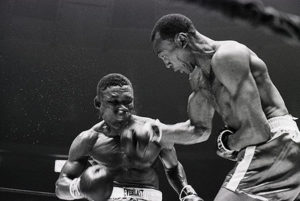
Right Hand Counters
Foster utilised a low lead guard defence, holding his left hand low, instead of high by his chin. This presented easy openings for his opponent to land the right hand, as it took more effort from Foster to react to right hands coming in his direction. After using his own left, usually in the form of a jab, his lead would always go back to it’s low position. In fact, I cannot recall a time where I’ve ever actually seen him hold it high.
In addition to bring his left hand back low, Foster would lean his upper body into the jab, which caused him to lose control of his balance and momentum. With his weight falling onto his front foot, this would move him into the counter. And just as importantly, his weight being forward meant that to move back out, or in any other direction, it would take a few moments longer than it could be. And this would be enough time for his opponent to land the right hand counter.
It must be noted that as the years went by, he started to adapt to incoming rights, and it became much less of an issue. In the worst case scenarios, he would roll with the punch, taking the impact out of it, even if it happened to land.
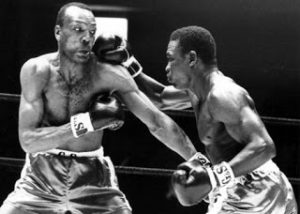
Bob Foster could be countered over his lazy jab
Low Angle Punches
With Foster being taller than most of his opponents, this inevitably meant that many opponents would be forced to punch at an upward angle naturally. For some, this could be to their disadvantage. But for others, this could be made to work in their favour. Fighters who embraced the crouching stance, would tempt Foster into throwing punches downwards, which would cause him to lean forward excessively over his front foot.
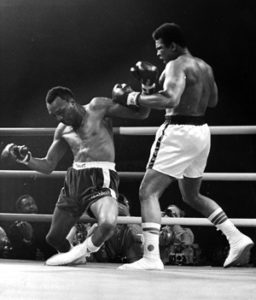
Muhummad Ali used the left repeatedly against Foster
Left Hooks
Opponent’s rarely established a meaningful jab against the light heavyweight champ. His side-on stance meant that it was easy for him to simply dip underneath it. However, the lead hand could still be extremely useful in the form of hooks. Foster’s torso would be facing to the right, due to his side-on stance. This meant that in order to directly meet his centreline, punches had to come from a side angle. This was also an effective counter against Foster’s jab, as he twisted (naturally) to his right when throwing the jab.
Even when facing directly forward, Foster would gift his opponent’s an opening for the hook by leaving his arms outstretched. He would do this to try and control or check his opponent’s glove by blocking it closer to his opponent, than himself. But this just created an opening around the side.
Foster was also susceptible to this when throwing the right hand, and he had twisted his body to the left. There were two ways that this could present a problem. At times, his opponents would catch him with the left before he had thrown his right hand. Usually, this would move him into the left hook without him seeing it coming, because it came outside of his field of vision. This was evident when Frazier knocked Foster down in their 1972 eeting. The other way was when Foster would throw the right hand, bringing his right side over and squaring himself up. This would present his opponent with a large tempting target.
Depending on the circumstances, the right hand + left hook (or vice versa) was a very effective combination, and was much more reliable than the conventional ‘jab-straight’ combination.
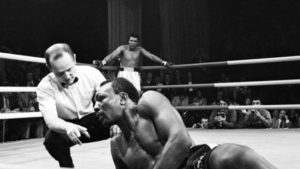
Foster continouosly bent into rising left hooks/ uppercuts
Rising Left Hooks
One of Foster’s primary methods of defence was to bend forward at the waist, taking his head off centre and lowering his head level. However, for opponents that threw their left from a low angle, this meant he moved his head directly into the punch. This increased the physical impact, but it would also instinctively surprise him, increasing the mental impact of the punch. This was frequently used by Muhummad Ali in their 1972 bout. A hybrid between an uppercut and hook, caught Bob Foster leaning into the punch, and would eventually knock him down.
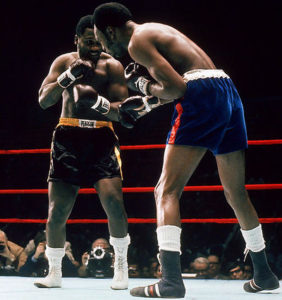
Foster took on heavyweights, giving up a weight advantage
FINAL NOTE
Bob Foster was well suited to fighters whose arsenal was limited to straight punches. However, for fighters who were able to throw punches from outside angles, as well as ones going at an upwards trajectory, Foster would have more problems. This was no doubt because he was most comfortable utilising a style that took advantage of his tall imposing figure. When forced to punch down, his balance would be compromised. When fighters broke from common patterns (e.g. throwing a 2-3 combination, instead of a 1-2), Foster would be caught off guard. Bob had little option but to develop a talent for rolling and fading punches, but his lowly-held guard inevitable gave away many cheap punching opportunities. That said, it was easier said than done. ‘The Sheriff’ defended his title 14 times, and is in history as one of the greatest champions we’ve seen.


Leave a Reply
Be the First to Comment!